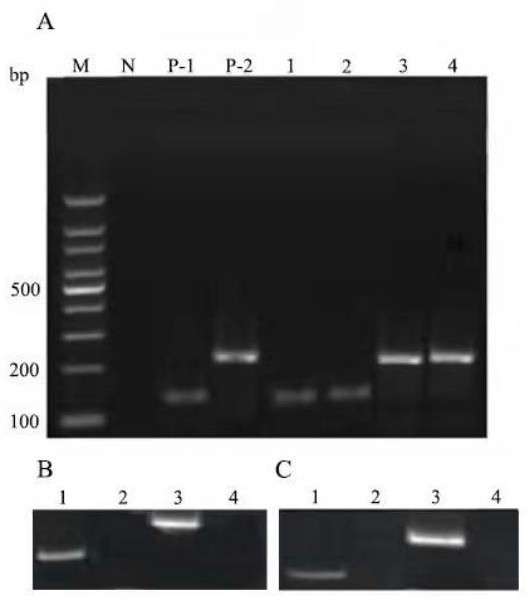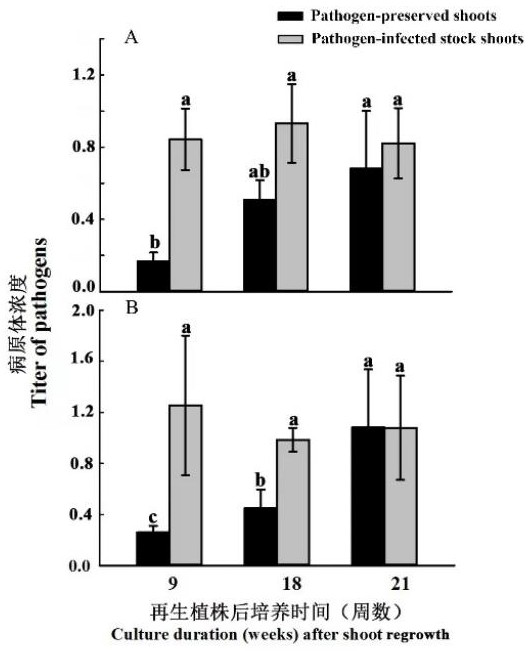Method for storing potato viruses and viroid in host for long time at ultralow temperature
A potato virus, long-term preservation technology, used in microorganism-based methods, viruses, horticultural methods, etc.
- Summary
- Abstract
- Description
- Claims
- Application Information
AI Technical Summary
Problems solved by technology
Method used
Image
Examples
Embodiment 1
[0033] The cryopreservation of embodiment 1 with poisonous shoot tip
[0034] The experimental operation method is as follows:
[0035] (1) The tube plantlets of potato "Zihuabai" which are highly sensitive to PVS and PSTVd were used as the experimental material, and the shoot tip was cut and transferred laterally into a disposable plastic petri dish containing MS, pH 5.8 medium.
[0036] (2) After sealing the culture dish, transfer it to the tissue culture room for culture for 1 week until the axillary buds germinate into 1 cm stem segments.
[0037] (3) Transfer the shoot tip in step (2) to a petri dish to harden the seedlings in a dark environment at 4°C for 3 weeks.
[0038] (4) Take 0.5-2.0 mm (carrying 5-6 leaf primordia) long shoot tips from the virus-carrying plants that have been hardened and pre-cultured.
[0039] (5) Pre-cultivation: This step is carried out on MS medium containing 0.3M sucrose and 8g / L agar, and treated at 4°C in the dark for at least 16h after...
Embodiment 2
[0045] The influence of embodiment 2 shoot tip size on pathogen storage rate
[0046] Operation steps are the same as embodiment 1, only change the shoot tip length used in the step (4). Take 0.5mm (2-3 leaf primordia) and 1.5mm (carry 5-6 leaf primordia) shoot tips respectively on hardened and pre-cultivated virus-carrying plants, by changing the size of the test shoot tips, study the effect of this variable on Effects on pathogen preservation and removal efficiency. Other parameters and experimental procedures were consistent with Example 1.
[0047] The measurement results are shown in Table 1:
[0048] Table 1 The effect of shoot tip size on the virus-free rate and virus preservation rate of the shoot tip cryopreservation of "Zihuabai" test-tube plantlets with PVS and PSTVd
[0049]
Embodiment 3
[0050] RT-PCR detection of plant pathogen carrying situation before and after cryopreservation in embodiment 3
[0051] A total of five RT-PCR tests were performed in this experiment. The first time is the detection of the poison source potato to the "Zihuabai" greenhouse virus transmission; the second time is to check the test tube seedlings with pathogens; the third time is to detect the third (9th week) plants of the regenerated subculture , as the result of the initial inspection, it is convenient for real time RT-qPCR virus quantitative detection; the fourth time is to detect the plants of the 6th (18th week) subculture after regeneration to obtain the preservation efficiency of the virus by ultra-low temperature freezing of the infected shoot tip; The fifth time is to detect the results of grafting and friction transmission to identify whether the regenerated pathogen has normal infection ability. The specific implementation method is as follows:
[0052] (1) RNA extra...
PUM
 Login to View More
Login to View More Abstract
Description
Claims
Application Information
 Login to View More
Login to View More - R&D
- Intellectual Property
- Life Sciences
- Materials
- Tech Scout
- Unparalleled Data Quality
- Higher Quality Content
- 60% Fewer Hallucinations
Browse by: Latest US Patents, China's latest patents, Technical Efficacy Thesaurus, Application Domain, Technology Topic, Popular Technical Reports.
© 2025 PatSnap. All rights reserved.Legal|Privacy policy|Modern Slavery Act Transparency Statement|Sitemap|About US| Contact US: help@patsnap.com



